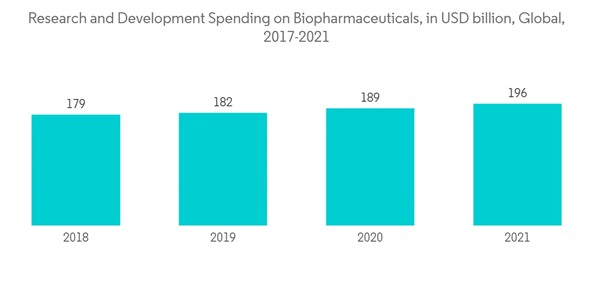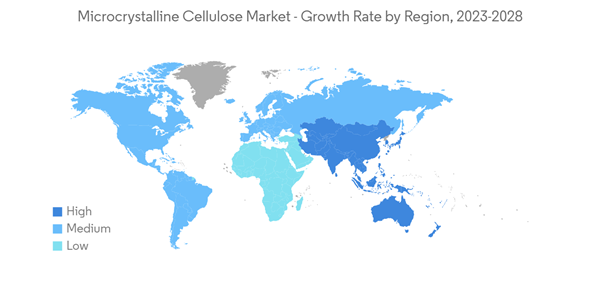During the time frame of the forecast, the microcrystalline cellulose market is expected to register a CAGR of over 6%.
Pharmaceuticals and cosmetics are the major end-user industries of microcrystalline cellulose. The coronavirus (COVID-19) pandemic altered the face of the beauty industry. As a result of months of consumer lockdowns, international travel bans, and retail business closures, sales, purchases, and usage fell across many beauty segments. However, the pharmaceutical industry experienced an increase in production due to the COVID-19 pandemic as the medicines used in hospitals around the world increased, thus increasing the demand for microcrystalline cellulose, which was used in the production of drugs. Furthermore, government support in various countries in the pharmaceutical sector is expected to positively influence the market studied.
This product will be delivered within 2 business days.
Pharmaceuticals and cosmetics are the major end-user industries of microcrystalline cellulose. The coronavirus (COVID-19) pandemic altered the face of the beauty industry. As a result of months of consumer lockdowns, international travel bans, and retail business closures, sales, purchases, and usage fell across many beauty segments. However, the pharmaceutical industry experienced an increase in production due to the COVID-19 pandemic as the medicines used in hospitals around the world increased, thus increasing the demand for microcrystalline cellulose, which was used in the production of drugs. Furthermore, government support in various countries in the pharmaceutical sector is expected to positively influence the market studied.
Key Highlights
- In the short term, demand for the market under consideration is likely to be driven by the growing demand for microcrystalline cellulose from the pharmaceutical industry in major economies around the world.
- On the other hand, the high costs of making microcrystalline cellulose are likely to slow the growth of the market that was studied.
- With more pharmaceutical products being made in countries like India and China, the Asia-Pacific region is expected to have the largest share of the market.
Microcrystalline Cellulose Market Trends
Increasing Demand from Pharmaceutical Industry
- MCC is a pure, partially depolymerized cellulose synthesized from an -cellulose precursor (type I) obtained as a pulp from fibrous plant material, with mineral acids reducing the degree of polymerization using hydrochloric acid.
- Microcrystalline cellulose is a commonly used excipient in the pharmaceutical industry. It has excellent compressibility properties and is used in solid dosage forms, such as tablets, and is the most widely used direct compression excipient, acting as a strong dry binder, tablet disintegrant, absorbent, filler or diluent, lubricant, and anti-adherent.
- MCC is one of the most commonly used direct compression binders and is often thought to be the best diluent for binding.
- It is used as a binder or diluent in both wet granulation and direct compression processes for oral tablet and capsule formulations. It also has lubricant and disintegrant properties, making it ideal for direct tableting.
- The pharmaceutical industry grows because of things like the number of diseases, how affordable medicines are, how people feel about them, government (and insurance company) policies, and how many medicines are available. This, in turn, increases the demand for microcrystalline cellulose.
- The global pharmaceutical industry is increasing with growing production in countries such as the United States, China, and India. India is a prominent and rapidly growing market for pharmaceuticals. It has the most US-FDA-compliant pharmaceutical plants outside of the US (more than 262, including APIs) and more than 2000 WHO-GMP-approved pharmaceutical plants, including 253 European Directorate of Quality Medicines (EDQM)-approved plants with modern, cutting-edge technology.
- The Chinese government has started policies to support and encourage domestic medical device innovation, providing opportunities for the market studied. As the second-largest healthcare industry globally, behind the United States, the country’s healthcare market has been more rigorous, especially in light of the COVID-19 pandemic in 2020. As of 2021, China holds 12% of the global pharmaceutical market, following the United States, which holds 40% of it.
- According to information released by the IFPMA, spending on research and development of biopharmaceuticals went up by a lot in 2021.
- So, because of the above factors, the use of microcrystalline cellulose in the pharmaceutical industry is likely to grow over the next five years.
Asia-Pacific to Dominate the Market
- The Asia-Pacific region is expected to dominate the market during the forecast period. The rising demand for microcrystalline cellulose from the pharmaceutical and cosmetics industries in countries like China and India is expected to drive the demand for microcrystalline cellulose in this region.
- In the world pharmaceutical stage, the pharmaceutical market of China is the second largest after that of the United States due to high domestic demand from hospitals and the large production base of APIs in the country. In 2021, the Chinese pharmaceutical industry witnessed a record number of new drug launches and emerged as a leading vaccine manufacturer and supplier during the COVID-19 pandemic. Presently, China is a global leader in the manufacturing and export of APIs, which account for about 20% of the world's total API production. This is due to greater government support and the low cost of utilities. In 2021, the Chinese API market had over 7,000 API manufacturers, which increased by five times in the last five years, with a production capacity exceeding 2 million tons per year.
- According to the Government of India, the Indian pharma industry's market size is expected to reach USD 130 billion by 2030. India has also sent pharmaceutical products to more than 200 countries, and it may do so again in the future.
- India is the largest provider of generic drugs, which satisfy 40% of the generic drug demand in the United States and 30% of that in the United Kingdom. The domestic drug manufacturers consist of a chain of around 10,500 companies.
- The largest producers of microcrystalline cellulose are based in the Asia-Pacific region. Some of the leading companies in the production of microcrystalline cellulose are Sigachi Industries Pvt. Ltd., Huzhou City Linghu Xinwang Chemical Co. Ltd., DuPont, Asahi Kasei Corporation, and J. Rettenmaier & Sohne GmbH + Co. KG, among others.
- South Korea has one of the world’s most exceptional beauty markets. New beauty trends and innovations, featuring sophisticated ingredients and aesthetically appealing packaging, are constantly on display. The South Korean cosmetics products market is expected to reach USD 1952.05 million by 2025.
- Because of the things listed above, it is expected that the market for microcrystalline cellulose in the Asia-Pacific region will grow a lot during the study period.
Microcrystalline Cellulose Market Competitor Analysis
The microcrystalline cellulose market is fragmented in nature, with only a few major players dominating the market. Some of the major companies in the market studied include DuPont, Chemfield Cellulose, Accent Microcell, Sigachi Industries Limited, and DFE Pharma, among others.Additional benefits of purchasing the report:
- The market estimate (ME) sheet in Excel format
- 3 months of analyst support
This product will be delivered within 2 business days.
Table of Contents
1 INTRODUCTION1.1 Study Assumptions
1.2 Scope of the Study
2 RESEARCH METHODOLOGY
3 EXECUTIVE SUMMARY
4 MARKET DYNAMICS
4.1 Drivers
4.1.1 Growing Demand for Microcrystalline Cellulose from Pharmaceutical Industry
4.2 Restraints
4.2.1 High Manufacturing and Production Cost
4.3 Industry Value Chain Analysis
4.4 Porter's Five Forces Analysis
4.4.1 Threat of New Entrants
4.4.2 Bargaining Power of Buyers
4.4.3 Bargaining Power of Suppliers
4.4.4 Threat of Substitute Products
4.4.5 Degree of Competition
4.5 Process Analysis
5 MARKET SEGMENTATION (Market Size in Value)
5.1 Source
5.1.1 Wood-based
5.1.2 Non -wood-based
5.2 Process
5.2.1 Reactive Extrusion
5.2.2 Enzyme Mediated
5.2.3 Steam Explosion
5.2.4 Acid Hydrolysis
5.3 End-User Industry
5.3.1 Pharmaceutical
5.3.2 Food
5.3.3 Cosmetics
5.3.4 Other End-User Industries
5.4 Geography
5.4.1 Asia-Pacific
5.4.1.1 China
5.4.1.2 India
5.4.1.3 Japan
5.4.1.4 South Korea
5.4.1.5 Rest of Asia-Pacific
5.4.2 North America
5.4.2.1 United States
5.4.2.2 Canada
5.4.2.3 Mexico
5.4.3 Europe
5.4.3.1 Germany
5.4.3.2 United Kingdom
5.4.3.3 France
5.4.3.4 Italy
5.4.3.5 Rest of Europe
5.4.4 South America
5.4.4.1 Brazil
5.4.4.2 Argentina
5.4.4.3 Rest of South America
5.4.5 Middle-East and Africa
5.4.5.1 Saudi Arabia
5.4.5.2 South Africa
5.4.5.3 Rest of Middle-East and Africa
6 COMPETITIVE LANDSCAPE
6.1 Mergers and Acquisitions, Joint Ventures, Collaborations, and Agreements
6.2 Market Share(%)** /Ranking Analysis
6.3 Strategies Adopted by Leading Players
6.4 Company Profiles
6.4.1 Accent Microcell
6.4.2 Asahi Kasei Corporation
6.4.3 Blanver
6.4.4 Chemfield Cellulose
6.4.5 DFE Pharma
6.4.6 DuPont
6.4.7 GUJARAT MICROWAX PVT. LTD.
6.4.8 Huzhou City Linghu Xinwang Chemical Co. Ltd.
6.4.9 J. RETTENMAIER & SÖHNE GmbH + Co KG
6.4.10 JUKU ORCHEM PVT. LTD.
6.4.11 MINGTAI CHEMICAL CO. LTD.
6.4.12 Sigachi Industries Limited
6.4.13 VWR International, LLC (Avantor, Inc.)
7 MARKET OPPORTUNITIES AND FUTURE TRENDS
7.1 Growing Demand of Microcrystalline Cellulose Composites as Lining Adhesives for Canvas
7.2 Other Opportunities
Companies Mentioned (Partial List)
A selection of companies mentioned in this report includes, but is not limited to:
- Accent Microcell
- Asahi Kasei Corporation
- Blanver
- Chemfield Cellulose
- DFE Pharma
- DuPont
- GUJARAT MICROWAX PVT. LTD.
- Huzhou City Linghu Xinwang Chemical Co., Ltd.
- J. RETTENMAIER & SÖHNE GmbH + Co KG
- JUKU ORCHEM PVT. LTD.
- MINGTAI CHEMICAL CO., LTD.
- Sigachi Industries Limited
- VWR International, LLC (Avantor, Inc.)
Methodology

LOADING...










